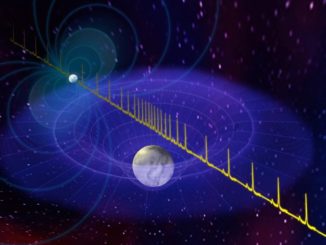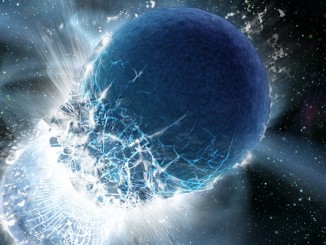
Researchers using different techniques to measure how fast the universe is expanding have come up with two different answers, a conflict that so far has resisted explanation. Researchers at the Massachusetts Institute of Technology say the conflict may be resolved by analysis of gravitational waves from neutron star-black hole mergers, resulting in a value for the Hubble constant, a measure of the Universe’s expansion, that is more precise than earlier results.
The only problem? No such mergers have yet been detected. But astronomers are hopeful the Laser Interferometry Gravitational Wave Observatory, or LIGO, will detect such mergers when it resumes operations early next year with upgraded, more sensitive components.
“So far, people have focused on binary neutron stars as a way of measuring the Hubble constant with gravitational waves,” said Salvatore Vitale, assistant professor of physics at MIT and lead author of the paper in Physical Review Letters. “We’ve shown there is another type of gravitational wave source which so far has not been exploited as much: black holes and neutron stars spiralling together.”
The Hubble constant is an indicator of how fast the universe is expanding. Researchers using the Hubble Space Telescope and the European Space Agency’s Gaia spacecraft to precisely measure the distances to Cepheid variable stars in the Milky Way and nearby galaxies have come up with a value of 73.5 kilometres (45.6 miles) per second per million parses.
Put another way, for every 3.3 million light years – 1 megaparsec – objects are moving away an additional 73.5 kilometres per second faster. The uncertainty in the measurement is just 2.2 percent.
But astronomers using ESA’s Planck spacecraft to study conditions in the extremely early universe came up with a value of 67 kilometres per second per megaparsec. The cause of the discrepancy is not yet known.
“That’s where LIGO comes into the game,” Vitale says. “Gravitational waves provide a very direct and easy way of measuring the distances of their sources. What we detect with LIGO is a direct imprint of the distance to the source, without any extra analysis.”
The bulk of the gravitational waves emitted in neutron star mergers originate at the center of the coalescing disk with smaller amounts originating from the edges, MIT said in a release describing the study. A strong, or “loud,” gravitational wave signal from the merger of two neutron stars could indicate waves from the edges of a nearby system or from the center of a much more distant source.
“With neutron star binaries, it’s very hard to distinguish between these two situations,” Vitale says.
But a neutron star-black hole merger is another matter. Computer analysis indicates that even if rare, they have the potential to produce signals that could result in extremely precise distance measurements based on the spin of the black hole around the captive neutron star.
“LIGO will start taking data again in January 2019, and it will be much more sensitive, meaning we’ll be able to see objects farther away,” Vitale said. “So LIGO should see at least one black hole-neutron star binary, and as many as 25, which will help resolve the existing tension in the measurement of the Hubble constant, hopefully in the next few years.”



